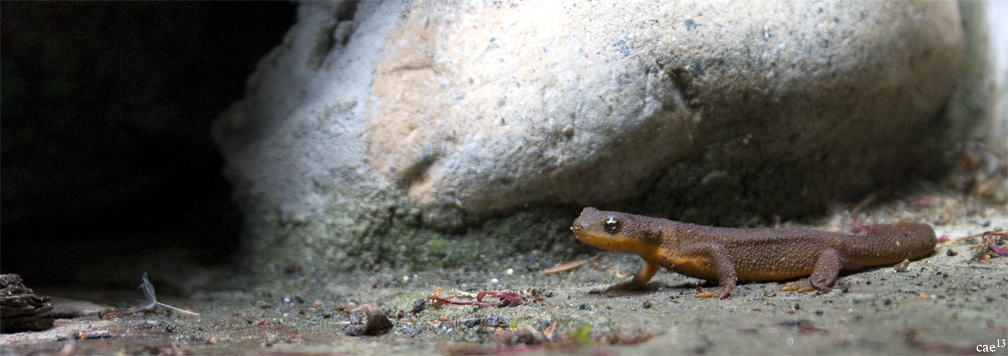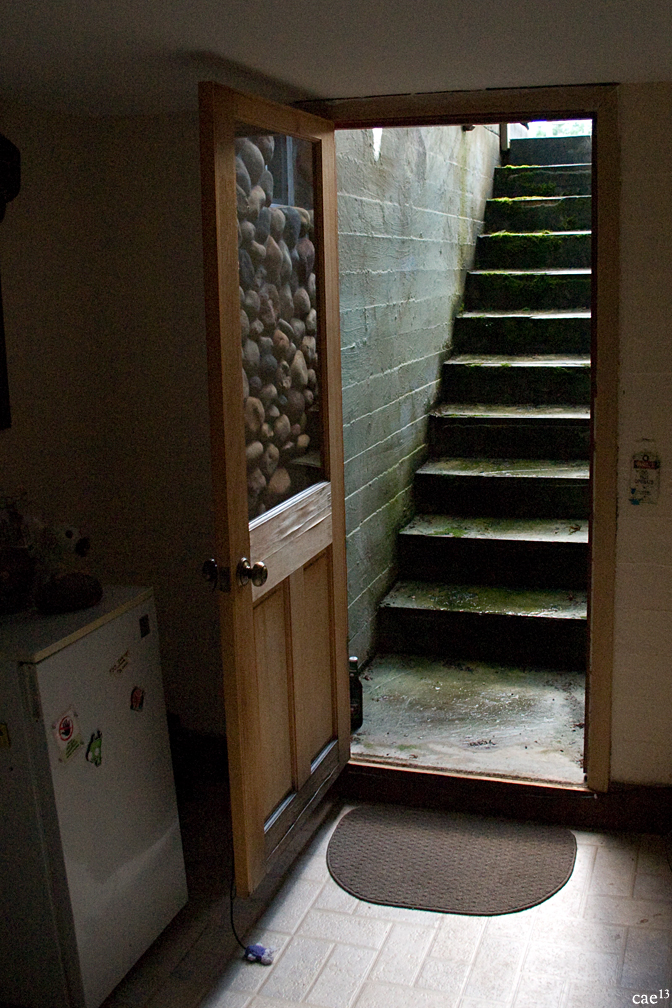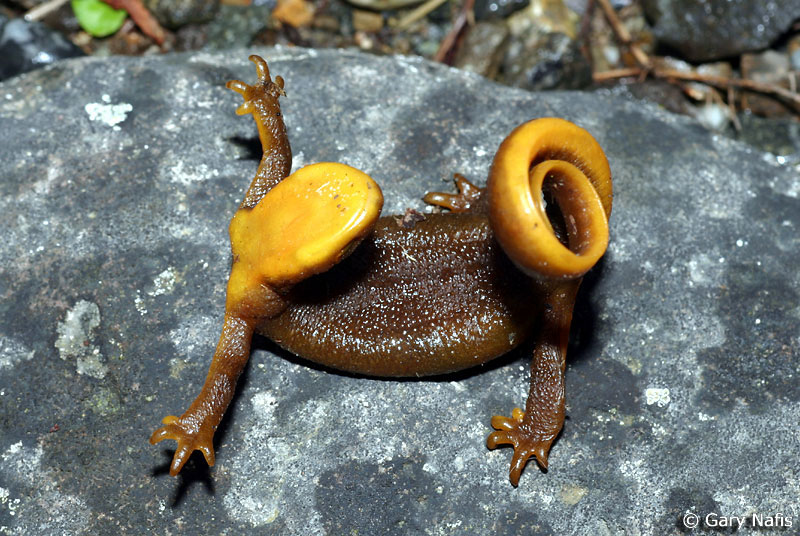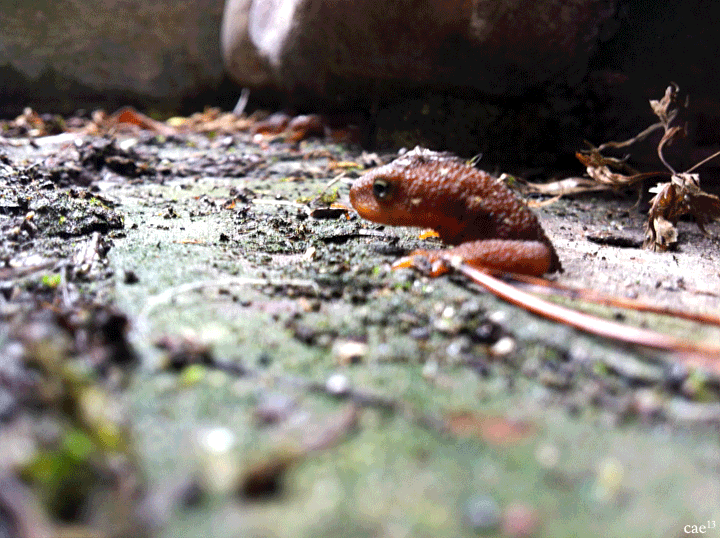Outside a rarely-used side-door in our basement, there is a concrete stairwell that spends a good part of the year damp and mossy. It gets afternoon sun, if there is any, and because of this, it dries up and stays that way throughout the bulk of the summer months but, autumn to spring, it’s a pretty moist environment.
There is a drain in the bottom landing of this stairway: a hole covered by a round, metal grate tucked halfway under the concrete facade of one wall. Our neighbors live here: Taricha granulosa – rough-skinned newts.
These newts, whom I have seen singly as well as in groups of up to five upon our steps, show up when the weather is dampish and hovering around the mid 50’s or 60’s. At least for part of the year, the newts appear to live down in the drain.
As with all wetland creatures, particularly amphibians, rough-skinned newts are endangered. Their habitat is shrinking and becoming poisoned with chemical runoff. I used to chuckle at all the “SLOW: NEWTS” signs one sees on rural roads around the Pacific Northwest because, yes, they are. Also: come on! I have to watch the road for teensy, weensy little crawling *newts*?
But it’s no laughing matter.
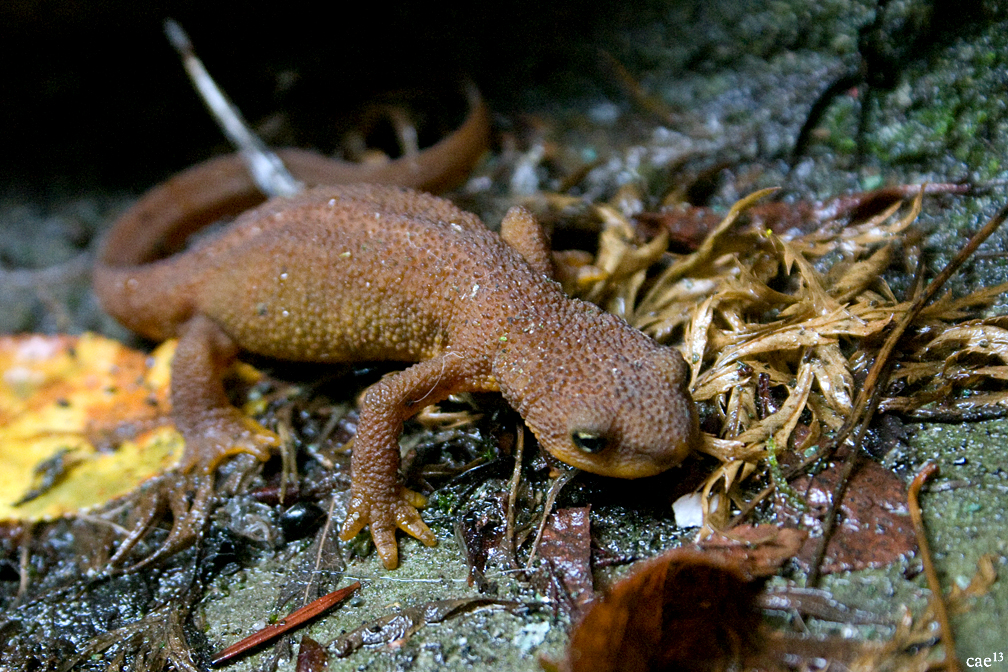 A big cause of this curious little creature’s decline can be pinned directly on being run over as they attempt to cross roads.
A big cause of this curious little creature’s decline can be pinned directly on being run over as they attempt to cross roads.
And why did the newt cross the road?
To get laid, of course!
Rough-skinned newts are primarily aquatic and, during the wet months, their breeding season, they make the potentially hectic trek to the pond or stream they were bred and hope to mate in. Like so many animals, they return to this same spawning ground over and over throughout their lives – if they don’t get run over.
I like amphibians as a rule and am saddened and concerned by their plight. Consequently, I worry a bit about my neighbors. I do use the staircase on occasion and wouldn’t want to accidentally step on one. Also, I know that some of the local rodentia muck about in this stairwell. I initially had concerns that they might attack or eat the newts that live here but now I know I probably needn’t worry. What it took me researching on the internet to learn, a rat likely already knows: my neighbors are *deadly* toxic.
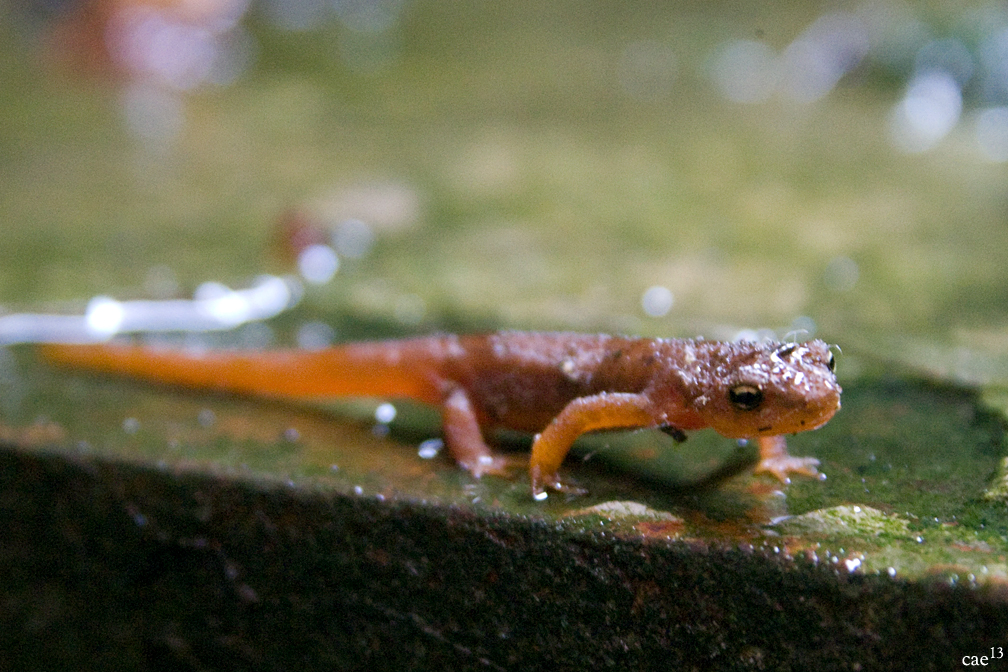 The poison they’re apparently saturated with is tetrodotoxin, or TTX. This toxin can also be found in Japanese puffer fish and some species of South American frogs. No known antidote exists for a tetrodotoxin, and it is carried by both juvenile and adult rough-skinned newts in glands in their skin, and even their eggs. Touch your mouth or eyes after handling one without washing afterwards and become ill. Put one in your mouth and die.
The poison they’re apparently saturated with is tetrodotoxin, or TTX. This toxin can also be found in Japanese puffer fish and some species of South American frogs. No known antidote exists for a tetrodotoxin, and it is carried by both juvenile and adult rough-skinned newts in glands in their skin, and even their eggs. Touch your mouth or eyes after handling one without washing afterwards and become ill. Put one in your mouth and die.
Good thing I heard about that before I gave them what I like to think of as “the proper Corey hello” … but I digress.
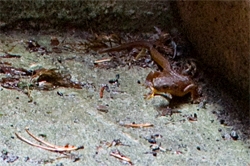 Whenever I open this door, I peer through the window first to see if the neighbors are out. They can be hard to see, autumn colored and blending in with the leaves that so oft litter these steps. When the weather is right, I almost always do see one, though: head up, peering about for yummy insects to eat or stalking around like a slightly tottery sloth. Usually, I will spot one and then, if I keep peering, at least one previously hidden newt will leap into obviousness; wedged into a crack, perhaps, or nestled amongst the leaves a step or two up.
Whenever I open this door, I peer through the window first to see if the neighbors are out. They can be hard to see, autumn colored and blending in with the leaves that so oft litter these steps. When the weather is right, I almost always do see one, though: head up, peering about for yummy insects to eat or stalking around like a slightly tottery sloth. Usually, I will spot one and then, if I keep peering, at least one previously hidden newt will leap into obviousness; wedged into a crack, perhaps, or nestled amongst the leaves a step or two up.
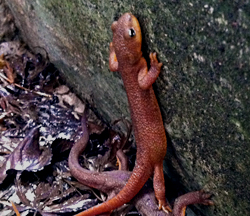 Therein lies a mystery: I don’t know how they hell they mount the steps. I’ve watched them try to climb on more than a couple of occasions and they’re forever teetering backwards onto their heads. Despite this display of clumsiness, half the time I look and there’s a newt, pointedly *not* looking back at me from its vantage point of the second or third step. I suspect their tight-fitting, little wet suits conceal miniature grappling hook apparatus …
Therein lies a mystery: I don’t know how they hell they mount the steps. I’ve watched them try to climb on more than a couple of occasions and they’re forever teetering backwards onto their heads. Despite this display of clumsiness, half the time I look and there’s a newt, pointedly *not* looking back at me from its vantage point of the second or third step. I suspect their tight-fitting, little wet suits conceal miniature grappling hook apparatus …
Beyond peering at them from behind the glass of the door, I typically leave my rough-skinned newt neighbors be and encourage others in the house to do the same. Particularly the cat, whom I’d hate to find dead with a half-chewed newt hanging out of his face. Sometimes, however, these compelling, little guys draw my camera lens.
The incident that spurred this post is a good case in point:
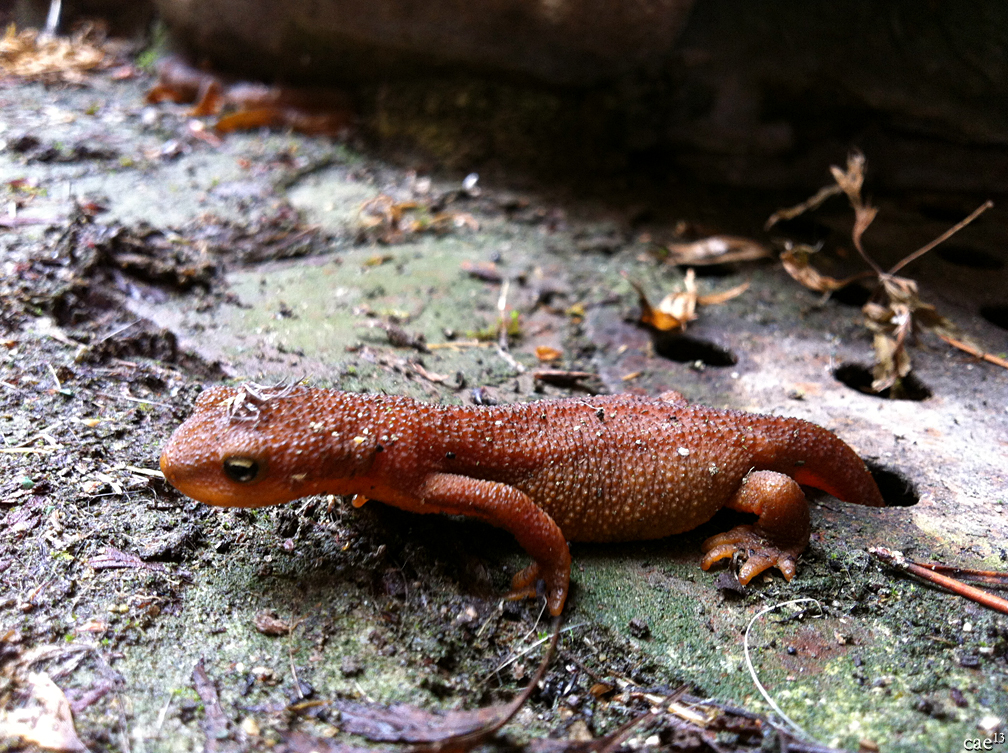 I was about to go out when I saw a newt on the landing, its tail still dangling down into one of the holes of the grate. “Well, that’s unique,” I think, pulling out my phone to take some pics. There is a festive bit of moss on the newt’s head. Nearby, another newt reclines under the shadow of the wall’s facade.
I was about to go out when I saw a newt on the landing, its tail still dangling down into one of the holes of the grate. “Well, that’s unique,” I think, pulling out my phone to take some pics. There is a festive bit of moss on the newt’s head. Nearby, another newt reclines under the shadow of the wall’s facade.
Now I know from experience that poking a camera into a newt’s face causes them to crouch down and cease being as photogenic. I’ve yet to see the unken reflex – a reaction to a threat that involves an upward arched head and tail to display their orange, “DANGER: POISON,” underbellies – but they definitely project discomfort at my rare intrusions. Luckily, they move at the speed of government (well, maybe not *that* slow) so, as in the instance at hand, I have ample time to get a few “surprise” shots of my friend with its tail in the grate before I head off, up the stairs on my original errand.
A few minutes later, when I come back down the stairs, the newt, in reaction to my previous intrusion, has eased itself partially back down the hole of the grate.
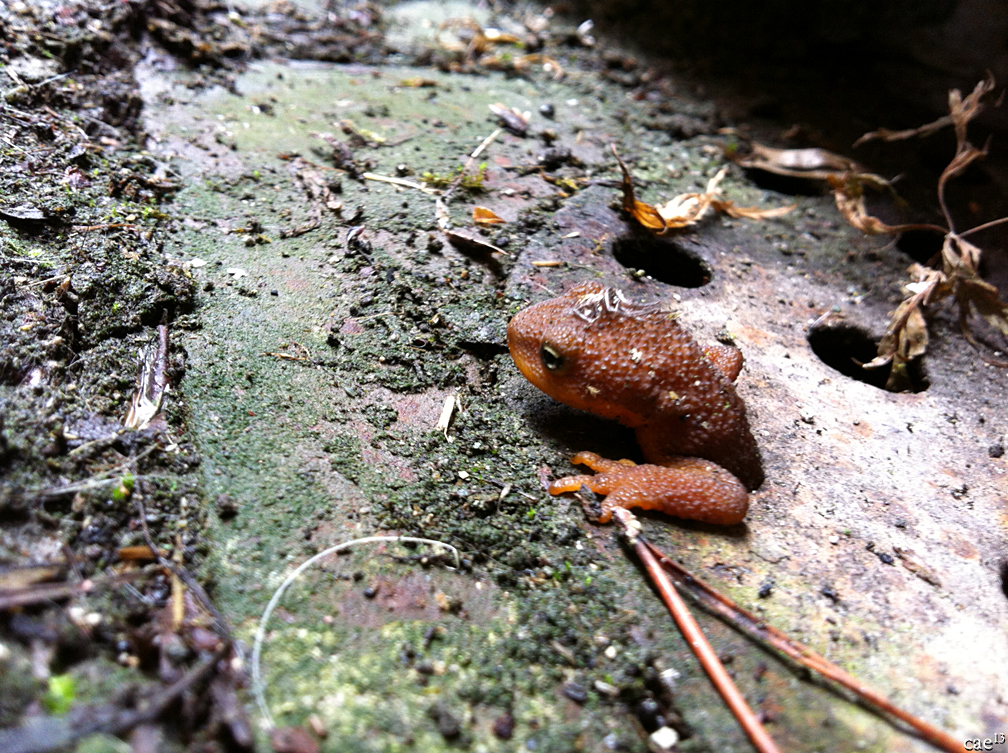 It sits there, appearing nonchalant, “arms” on either side of the hole, foliage-festooned head poking up out of the blackness. It looks, for all the world, like a tourist at the edge of the pool, waiting patiently for its parasoled drink. Clearly, more pictures are called for.
It sits there, appearing nonchalant, “arms” on either side of the hole, foliage-festooned head poking up out of the blackness. It looks, for all the world, like a tourist at the edge of the pool, waiting patiently for its parasoled drink. Clearly, more pictures are called for.
As I kneel and prop myself in the tight space to wangle focus and angle for my lens, the newt is re-invigorated towards active flight. Arching backwards and wriggling awkwardly, it slowly sinks from sight, its little arms folding up like those of an empty, rubber suit as they pass through the restrictive circumference of the grate’s metal hole.
Stupidly, I continue trying to use my phone for static images, rather than switching to video – wotta maroon. Still, I capture enough of a series to make the fun, little animated gif, below. Keep in mind that the actual sequence took about twice the time to play out as the gif does. You’ll have to provide your own music sound effects …

